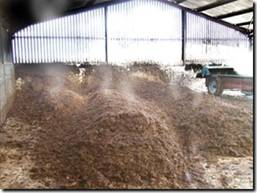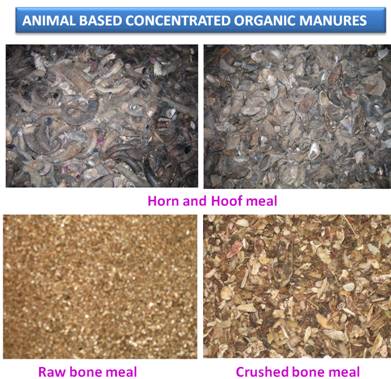MANURES
Manures are plant and
animal wastes that are used as sources of plant nutrients. They
release nutrients after their decomposition. The art of collecting and
using wastes from animal, human and vegetable sources for improving
crop productivity is as old as agriculture. Manures are the organic
materials derived from animal, human and plant residues which contain
plant nutrients in complex organic forms. Naturally occurring or
synthetic chemicals containing plant nutrients are called fertilizers.
Manures with low nutrient, content per unit quantity have longer
residual effect besides improving soil physical properties compared to
fertilizer with high nutrient content. Major sources of manures are:
-
Cattle shed wastes-dung, urine and slurry from biogas plants
-
Human habitation wastes-night soil, human urine, town refuse, sewage, sludge and sullage
-
Poultry Jitter, droppings of sheep and goat
-
Slaughterhouse wastes-bone meal, meat meal, blood meal, horn and hoof meal, Fish wastes
-
Byproducts of agro industries-oil cakes, bagasse and press mud, fruit and vegetable processing wastes etc
-
Crop wastes-sugarcane trash, stubbles and other related material
-
Water hyacinth, weeds and tank silt, and
-
Green manure crops and green leaf manuring material
Manures can also be grouped,
into bulky organic manures and concentrated organic manures based on
concentration of the nutrients.
Bulky organic manures
Bulky organic manures
contain small percentage of nutrients and they are applied in large
quantities. Farmyard manure (FYM), compost and green-manure are the
most important and widely used bulky organic manures. Use of bulky
organic manures has several advantages:
(1) They supply plant nutrients including micronutrients
(2)They improve soil physical properties like structure, water holding capacity etc.,
(3) They increase the availability of nutrients
(4) Carbon dioxide released during decomposition acts as a CO2 fertilizer and
(5) Plant parasitic nematodes and fungi are controlled to some extent by altering the balance of microorganisms in the soil.
(1) They supply plant nutrients including micronutrients
(2)They improve soil physical properties like structure, water holding capacity etc.,
(3) They increase the availability of nutrients
(4) Carbon dioxide released during decomposition acts as a CO2 fertilizer and
(5) Plant parasitic nematodes and fungi are controlled to some extent by altering the balance of microorganisms in the soil.
Farmyard manure
Farmyard manure
refers to the decomposed mixture of dung and urine of farm animals
along with litter and left over material from roughages or fodder fed
to the cattle. On an average well decomposed farmyard manure contains
0.5 per cent N, 0.2 per cent P2O5and .0.5 per cent K2O.The present
method of preparing farmyard manure by the farmers is defective. Urine,
which is wasted, contains one per cent nitrogen and 1.35 per cent
potassium. Nitrogen present in urine is mostly in the form of urea
which is subjected to volatilization losses. Even during storage,
nutrients are lost due to leaching and volatilization. However, it is
practically impossible to avoid losses altogether, but can be reduced
by following improved method of preparation of farmyard manure.
Trenches of size 6 m to 7.5 m length, 1.5 m to 2.0 m width and 1.0 m
deep are dug.
All available litter and refuse
is mixed with soil and spread in the shed so as to absorb urine. The
next morning, urine soaked refuse along with dung is collected and
placed in the trench. A section of the trench from one end should be
taken up for filling with daily collection. When the section is filled
up to a height of 45 cm to 60 cm above the ground level, the top of the
heap is made into a dome and plastered with cow dung earth slurry. The
process is continued and when the first trench is completely filled,
second trench is prepared.
The manure becomes
ready for use in about four to five months after plastering. If urine
is not collected in the bedding, it can be collected along with
washings of the cattle shed in a cemented pit from which it is later
added to the farmyard manure pit. Chemical preservatives can also be
used to reduce losses and enrich farmyard manure. The commonly used
chemicals are gypsum and superphosphate. Gypsum is spread in the cattle
shed which absorbs urine and prevents volatilization loss of urea
present in the urine and also adds calcium and sulphur. Superphosphate
also acts similarly in reducing losses and also increases phosphorus
content.
Partially rotten farmyard
manure has to be applied three to four weeks before sowing while well
rotten manure can be applied immediately before sowing. Generally 10 to
20 t/ha is applied, but more than 20 t/ha is applied to fodder grasses
and vegetables. In such cases farmyard manure should be applied at
least 15 days in advance to avoid immobilization of nitrogen. The
existing practice of leaving manure in small heaps scattered in the
field for a very long period leads toloss of nutrients. These losses
can be reduced by spreading the manure and incorporating by ploughing
immediately after application.
Vegetable crops like
potato, tomato, sweet-potato, carrot, raddish, onion etc., respond well
to the farmyard manure. The other responsive crops are sugarcane,
rice, napier grass and orchard crops like oranges, banana, mango and
plantation crop like coconut.
The entire amount of
nutrients present in farmyard manure is not available immediately.
About 30 per cent of nitrogen, 60 to 70 per cent of phosphorus and 70
per cent of potassium are available to the first crop.


Farm yard manure
Sheep and Goat Manure
The droppings of
sheep and goats contain higher nutrients than farmyard manure and
compost. On an average, the manure contains 3 per cent N, 1 per cent
P2O5 and 2 per cent K2O.It is applied to the field in two ways. The
sweeping of sheep or goat sheds are placed in pits for decomposition and
it is applied later to the field. The nutrients present in the urine
are wasted in this method. The second method is sheep penning,
wherein sheep and goats are kept overnight in the field and urine and
fecal matter added to the soil is incorporated to a shallow depth by
working blade harrow or cultivator or cultivator.
Poultry Manure
The excreta of birds
ferment very quickly. If left exposed, 50 percent of its nitrogen is
lost within 30 days. Poultry manure contains higher nitrogen and
phosphorus compared to other bulky organic manures. The average nutrient
content is 3.03 per cent N; 2.63 per cent P2O5 and 1.4 per cent K2O.
Concentrated organic manures
Concentrated organic
manures have higher nutrient content than bulky organic manure. The
important concentrated organic manures are oilcakes, blood meal, fish
manure etc. These are also known as organic nitrogen fertilizer. Before
their organic nitrogen is used by the crops, it is converted through
bacterial action into readily usable ammoniacal nitrogen and nitrate
nitrogen. These organic fertilizers are, therefore, relatively slow
acting, but they supply available nitrogen for a longer period.
Oil cakes
After oil is
extracted from oilseeds, the remaining solid portion is dried as cake
which can, be used as manure. The oil cakes are of two types:
1. Edible oil cakes which can be safely fed to livestock; e.g.: Groundnut cake, Coconut cake etc., and
2. Non edible oil cakes which are not fit for feeding livestock; e.g.: Castor cake, Neem cake, Mahua cake etc.,
Both edible and non-edible oil cakes can be used as manures. However, edible oil cakes are fed to cattle and non-edible oil cakes are used as manures especially for horticultural crops. Nutrients present in oil cakes, after mineralization, are made available to crops 7 to 10 days after application. Oilcakes need to be well powdered before application for even distribution and quicker decomposition.
2. Non edible oil cakes which are not fit for feeding livestock; e.g.: Castor cake, Neem cake, Mahua cake etc.,
Both edible and non-edible oil cakes can be used as manures. However, edible oil cakes are fed to cattle and non-edible oil cakes are used as manures especially for horticultural crops. Nutrients present in oil cakes, after mineralization, are made available to crops 7 to 10 days after application. Oilcakes need to be well powdered before application for even distribution and quicker decomposition.

The average nutrient content of different oil-cakes is presented in the following table.
Average nutrient content of oil cakes
Oil-cakes
|
Nutrient content (%)
|
||
N
|
P2O5
|
K2O
|
|
Non edible oil-cakes
|
|||
Castor cake
|
4.3
|
1.8
|
1.3
|
Cotton seed cake (undecorticated)
|
3.9
|
1.8
|
1.6
|
Karanj cake
|
3.9
|
0.9
|
1.2
|
Mahua cake
|
2.5
|
0.8
|
1.2
|
Safflower cake (undecorticated)
|
4.9
|
1.4
|
1.2
|
Edible oil-cakes
|
|||
Coconut cake
|
3.0
|
1.9
|
1.8
|
Cotton seed cake (decorticated)
|
6.4
|
2.9
|
2.2
|
Groundnut cake
|
7.3
|
1.5
|
1.3
|
Linseed cake
|
4.9
|
1.4
|
1.3
|
Niger cake
|
4.7
|
1.8
|
1.3
|
Rape seed cake
|
5.2
|
1.8
|
1.2
|
Safflower cake (decorticated)
|
7.9
|
2.2
|
1.9
|
Sesamum cake
|
6.2
|
2.0
|
1.2
|
Other Concentrated Organic Manures
Blood meal when dried
and powdered can be used as manure. The meat of dead animals is dried
and converted into meat meal which is a good source of nitrogen.
Average nutrient content of animal based concentrated organic manures
is given as follows.

Average nutrient content of animal based concentrated organic manures
Organic manures
|
Nutrient content (%)
|
||
N
|
P2O5
|
K2O
|
|
Blood meal
|
10 - 12
|
1 - 2
|
1.0
|
Meat meal
|
10.5
|
2.5
|
0.5
|
Fish meal
|
4 - 10
|
3 - 9
|
0.3 - 1.5
|
Horn and Hoof meal
|
13
|
-
|
-
|
Raw bone meal
|
3 - 4
|
20 - 25
|
-
|
Steamed bone meal
|
1 - 2
|
25 - 30
|
-
|
Source
-
Reddy, S.R.2005. Principles of Agronomy. Kalyani Publisher, Ludhiana.
-
http://swastikbone.com/images/products/large/bonegrist.jpg
-
http://swastikbone.com/images/products/large/horns.jpg
-
http://swastikbone.com/images/products/large/hoofs.jpg
-
http://swastikbone.com/images/products/large/crushedbone.jpg
-
http://swastikbone.com/images/products/large/Bone-Meal.jpg
-
http://www.komitkompost.co.uk/images/pile321241.jpg
-
http://www.idrc.ca/openebooks/337-9/f0026-03.jpg




























1 comments:
Universal Water Chemicals is leading manufacturer and supplier of water treatment chemicals and water treatment plants for more information please contact +919849079566 or +7416079566
Post a Comment
ഇത് വായിച്ചു തീര്ന്നപ്പോള് എന്താണ് നിങ്ങളുടെ മനസ്സില് തോന്നുന്നത്. അത് ഇവിടെ കൂറിച്ചിടൂ...അനുകൂലമായാലും പ്രതികൂലമായാലും...
لا تتردد في إضافة التعليقات أو الاقتراحات بعد قراءة هذه المادة.
कृपया इस लेख को पढ़ने के बाद अपनी टिप्पणी या सुझाव पोस्ट करने के लिए स्वतंत्र महसूस हो रहा है.